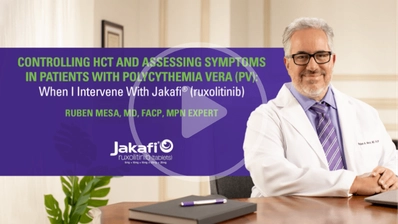Jakafi® (ruxolitinib) symptom data

Up to 80% or more of patients in my practice are symptomatic despite being on hydroxyurea. It’s crucial that I identify and tease out symptoms when I talk to my patients, especially as some symptoms are present before diagnosis and some patients aren’t aware they may be related to their polycythemia vera.
Andrew Kuykendall, MD, MPN Expert
Exploratory endpoint from the RESPONSE trial
- At week 32, 49% of patients receiving Jakafi and 5% of patients receiving BAT had at least a 50% reduction in the 14-item Myeloproliferative Neoplasm Symptom Assessment Form (MPN-SAF) Total Symptom Score1
- RESPONSE was an open-label trial and, therefore, not designed to evaluate differences in symptoms2
- Patient-reported outcomes were assessed using the MPN-SAF symptom diary. The MPN-SAF diary was administered daily in an electronic diary format to score 14 disease-related symptoms on a scale of 0 (absent) to 10 (worst possible). At baseline, median Total Symptom Score was 23.4 (range, 0-106) in the group receiving Jakafi and 33.3 (range, 0-118) in the group receiving BAT1,3

From The New England Journal of Medicine, Vannucchi AM, Kiladjian JJ, Griesshammer M, et al, Ruxolitinib versus standard therapy for the treatment of polycythemia vera, 372, 426-435. Copyright © 2015 Massachusetts Medical Society. Reprinted with permission from Massachusetts Medical Society.
aHigher symptom score indicates greater severity of symptoms. Cytokine symptom cluster includes tiredness, itching, muscle ache, night sweats, and sweating while awake; hyperviscosity symptom cluster includes vision problems, dizziness, concentration problems, headache, numbness or tingling in the hands or feet, ringing in the ears, and skin redness; and splenomegaly symptom cluster includes abdominal discomfort and early satiety. Patients with data at both baseline (value >0) and week 32 were included in this analysis.1
Exploratory endpoint from the RESPONSE trial
- Patients receiving Jakafi had greater reductions in all symptom clusters reported, whereas patients receiving BAT had an increase in scores of many symptoms1

This analysis is exploratory in nature and these results should be interpreted with caution.
From The New England Journal of Medicine, Vannucchi AM, Kiladjian JJ, Griesshammer M, et al, Ruxolitinib versus standard therapy for the treatment of polycythemia vera, 372, 426-435. Copyright © 2015 Massachusetts Medical Society. Reprinted with permission from Massachusetts Medical Society.
aPatients with data at both baseline (value >0) and week 32 were included in this analysis. Negative values indicate a reduction in the severity of symptoms.1
When I have patients who are unable to achieve hematocrit control below 45%, and are experiencing symptoms such as fatigue, pruritus, or night sweats, this tells me that hydroxyurea is no longer sufficient. And that’s when I typically intervene with Jakafi.
HEAR FROM DR MESA ABOUT SYMPTOM MANAGEMENTBAT=best available therapy; Hct=hematocrit; RESPONSE=Randomized study of Efficacy and Safety in POlycythemia vera with JAK iNhibitor ruxolitinib verSus bEst available care; WBC=white blood cell.
References: 1. Vannucchi AM, Kiladjian JJ, Griesshammer M, et al. Ruxolitinib versus standard therapy for the treatment of polycythemia vera. N Engl J Med. 2015;372(5):426-435. Supplementary appendix available at: https://www.nejm.org/doi/suppl/10.1056/NEJMoa1409002/suppl_file/nejmoa1409002_appendix.pdf. 2. Jakafi [package insert]. Wilmington, DE: Incyte Corporation. 3. Data on file. Incyte Corporation. Wilmington, DE.


